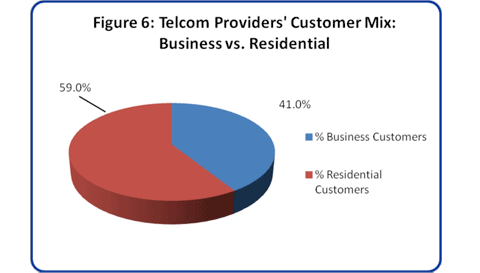
article page
| 1
| 2
| 3
| 4
| 5 |
Telcos, on the other hand, have a more balanced mix between business and residential users. Business users are high-margin customers and ones that the telcos will battle for. Historically, residential customers have been viewed as low margin accounts and telcos have been, at times, less effective in competing for these customers. The results have been continuous line losses for the telcos due to a number of factors. Competition from cable companies providing voice services is one factor that continues to rise in importance.
|
|
Overall, the U.S. telecommunications industry remains the most advanced in the world. |
|

business and residential subscribers in larger metropolitan areas. Ma Bell, founded over 100 years ago, took pride in its engineering prowess and inventiveness. Overall, the U.S. telecommunications industry remains the most advanced in the world.
|
|
|
|

Cable companies have much more to gain as they continue their assault on telco strongholds. Telcos, however, are well-positioned to hold off these competitors as they themselves turn their attention on cablecos' core video markets.
The Competitors
Cablecos and telcos come from vastly different origins and to some extent geography and technology kept them apart. As we're witnessing, technological shifts for both cable providers and telcos have opened the doors for each side to compete in the other's core markets.
Cable operators began by serving rural communities that had difficulty receiving broadcast TV signals. These operators deployed “community antennae” that were able to receive television signal (hence the reference by many to CATV). These signals were then transported via coaxial cable to subscribers. This industry's leaders, such as Bill Bresnan, John Malone, and Glenn Jones, created an entrepreneurial spirit that is still embraced by cable providers today.
The major telcos (those with their roots in the Bell system), on the other hand, focused on providing voice telephony services to both
|
|

There are approximately 1,200 cable television service providers and 1,100 incumbent telecommunications providers serving markets throughout the U.S. Many of these providers are smaller entities serving small markets. Table 1 below shows the top five cable and telecom service providers as a point of reference.
While the top five service providers under each heading represent the lion's share of the market, each "Tier 2" provider, be it cable or telco, has similar opportunities and market decisions before them.
So, Who's Going to Win This Thing?
Each side has a number of strengths to be effective competitors and gain market share in the other's core markets. Unfortunately for them, they also have counterbalancing weaknesses that mitigate any advantages provided them by their core strengths. However, neither side has an Achilles's heal.
article page
| 1 | 2 | 3
| 4 | 5 | |
|





